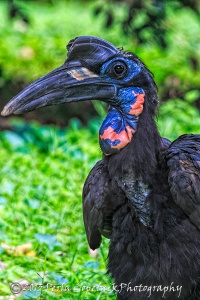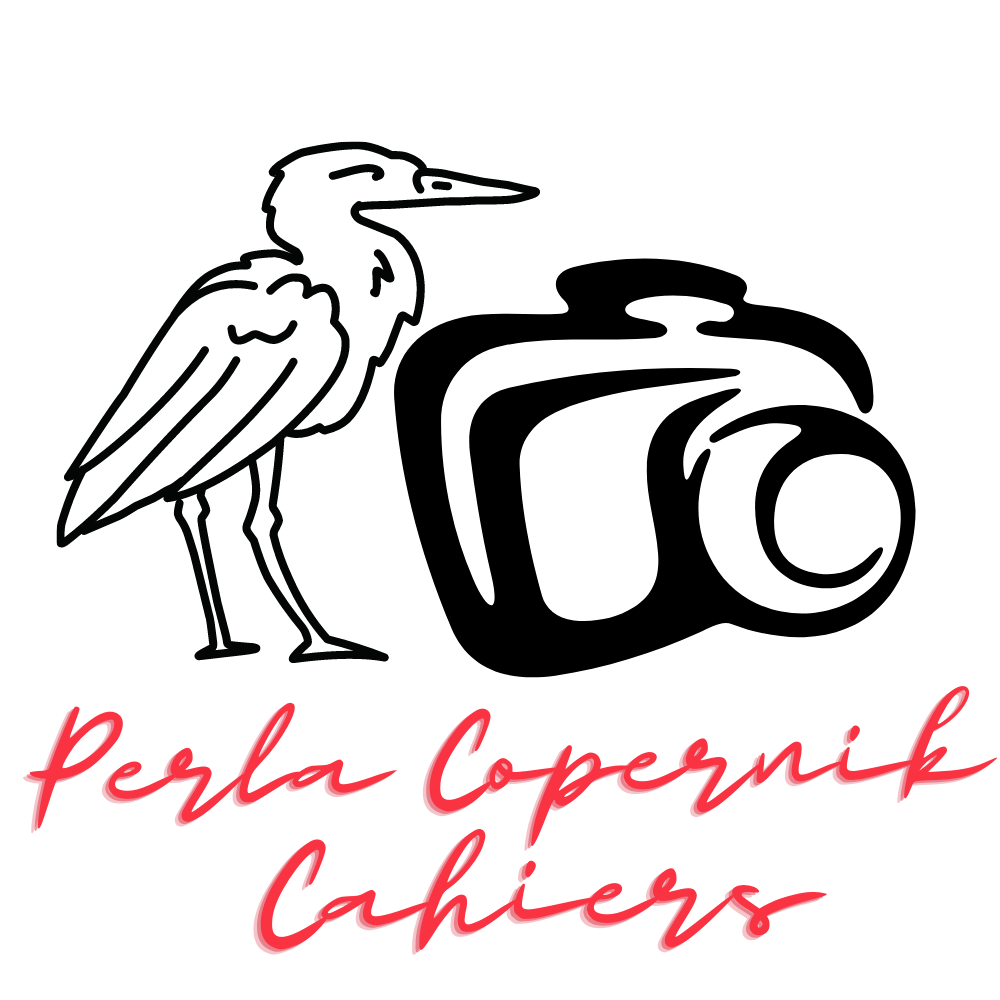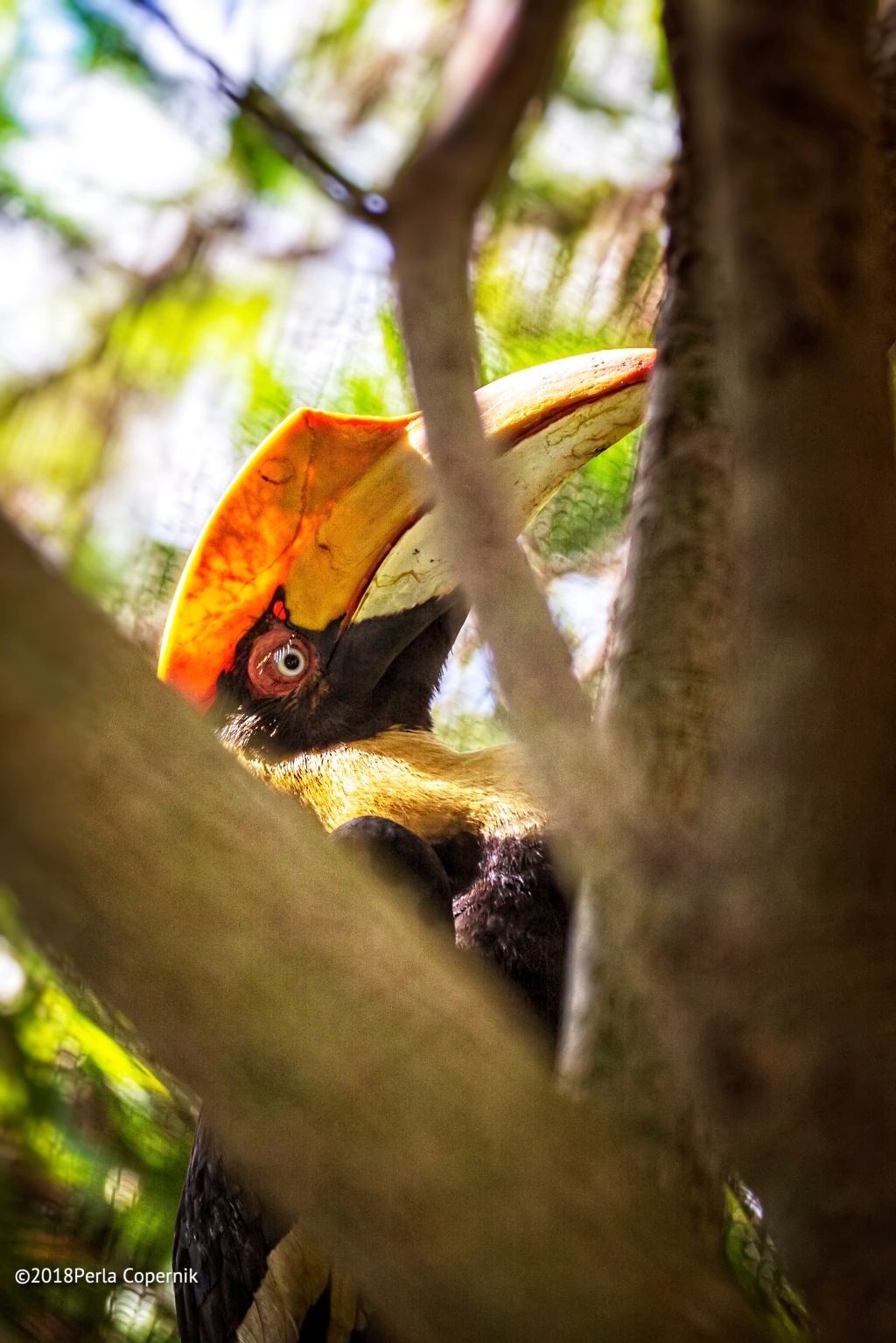“No bird soars too high if he soars with his own wings.”
-William Blake

There are many fascinating things about these amazingly weird looking birds; a couple of them are pretty obvious their colorful and in some species huge casques and large bills. The other one, which is not so obvious, but very interesting, is their breeding behavior or more particularly their nesting habits.
When you see a hornbill, the first thing you notice is the brilliant colors of the birds, but in reality if you pay attention, the plumage of the hornbill is generally black or white or a combination of both resulting in gray, brown or cream feathers.
The bright and extravagant colors that we seem to notice right away are from the bare parts. The large bill, the casque that’s placed on top of it, the bare skin around the eyes, the naked throat, the eyelids or the eyes themselves can be colored red, orange, yellow, blue, green, brown, black or white. The colors are sometimes displayed as large solid areas, or as intricate patterns. On the bill and casque, the patterns can be enhanced by a series of ridges or grooves, which are used to determine the age and sex of the animal, while, on the throat, they can be presented as small patches of wrinkled skin or, in some species, cover an inflated pouch.
So where do those colors come from? Well, they come from a secretion produced by the uropygial gland that consists of a complex mixture of waxes, (Jacob and Ziswiler 1982) and it is used as a cosmetic or makeup. Indeed several (eight out of 54) species of hornbill (the Asiatic genera Buceros , Aceros , Penelopides , and Rhinoplax ) produce a colored uropygial gland secretion, which they elaborately preen onto their plumage and casque, changing their color (Kemp 2001)(Delhey et al., 2007). The secretion ranges from yellow to red depending on the species, probably through the presence of carotenoids (Vevers 1964). These oxidize quickly, causing the colors to fade, so frequent reapplication is required to maintain the coloration (Vevers 1964). Apparently only adult (sexually mature) birds develop the coloration, and there is substantial individual variation in the degree of coloration. Like many of the mysteries surrounding the hornbills, the function of cosmetic color changes is unknown although it has been hypothesized that they may enhance sexual attractiveness or reduce conspicuousness to predators (Montgomerie 2006b; Delhey et al. 2007).
The large bill varies among species, from being relatively short and deep to being long and slender. It is always decurved in shape, but the degree of curvature varies. The bill is also deeper than it is wide, at least at the base, and as we will see later it plays an important role during the breeding season. In addition, the bill is used to chisel off bark, and the mass of the casque may increase the bill’s momentum, like a weighted digging stick.

The casque on the top of the bill is a structure that is unique to the hornbills, and one which shows the diversity of forms among the members of the family. It can be a low ridge running almost to the tip of the bill, or a large casque, that develops as a hollow structure from the outer keratin covering of the jaw. In its most extreme form, like in the Black-casqued Hornbill (Ceratogymna atrata) or in the Yellow-casqued Hornbill (Ceratogymna elata) it becomes a large hollow cylinder.
There are many theories as what exactly would be the function of such a prominent casque. It probably has multiple functions, like a resonating chamber, enhancing the resonance of the syringeal membranes which could perhaps account for the loud nasal calls of several large hornbill species. But the most obvious seems to be related to competition between members of the same sex, a theory that seems to be supported by aerial casque-butting contests between rival males.
What About the Hornbill’s Breeding Habits?
Well, for the most part is quite similar to other families of birds. Although some species engage in cooperative breeding, hornbills generally form monogamous pairs and mate for life. As the toucans, woodpeckers and other birds’ species, all hornbill species try to nest in natural nest cavities, and I say try because the indiscriminate deforestation of their habitats, particularly in Asia, is taking a toll on the survival of many of that region’s hornbill species.

When a new pair forms, they visit together many potential nest-sites before deciding on one, but guess who has the final say? Everything indicates that the final selection of the cavity is made by the female, after all, it is the female that will be sealing herself into the nest-cavity, leaving only a narrow elongated vertical slit through which the male passes her and the future chicks food. Also while, in the nest, the female becomes flightless, she molts both, her flight-feathers, and tail feathers becoming completely dependable on the male for protection and food during the nesting period. And if this peculiarity is not enough, she and later the chicks keep their nests clean by squirting their droppings out through the slit in the sealed nest entrance.

As soon as the female has attained breeding condition she enters the nest and begins the process of sealing herself into it. The female seals the hole with her perfectly tailored bill, The bill is also deeper than it is wide, at least at the base, and the flat sides provide the trowel-like surface that is used to apply sealing material to the nest entrance. According to the Handbook of the Birds of the World, volume 5, sealing is performed by using droppings, mud or sticky food remains, which are held in the bill while its sides are vibrated against the entrance, either one side at a time or, if the edges of the nesting cavity are close together, in a side-to-side movement. The sealing materials are then squeezed out between the tomia (the sharp ventral edges) of the bill and plastered onto the entrance rim. The exact application of the sealant is controlled by changing the portion of the bill used in the process, from the fine tip to the broader base, and by altering the angle at which the head is held in relation to the nest entrance.The process of sealing the entrance hole can be completed within a couple of hours, to a couple of days.
When the female or chicks decide to leave the nest, the sealing material is pecked away from within, using the bill. This process usually takes only a few hours, and sufficient material is removed just to enable the bird to emerge. The female and chicks fly immediately on emergence, and they do not re-enter the nest until a later season (Handbook of the Birds of the World, Volume 5).
As always there are exceptions to the rules and both the Southern-ground Hornbill and the Abyssinian-ground Hornbill are the exception in this case, because they do not seal the nest entrance, or display any molt, and they do not practice any type of nest sanitation. In very rare occasions, the Southern-ground Hornbill will nest on an abandoned open stick nest from another bird species or will excavate a cavity in an earthen bank (Handbook of the Birds of the World, Volume 5).

Although there is no solid proof, scientists believe that this curious nesting behavior of hornbills probably provides a great degree of anti-predator advantage. In fact, it has been shown that hole-nesting birds suffer lower predation rates than do those that build open nests.
Of course there is no degree of sealing nests or another type of protection that can prevent humans, the worst predator that ever existed, to send this magnificent keystone species to eternal extinction. So as previously promised in my post Nuts About Hornbills: A Fascinating Evolutionary Story, I will be discussing the wonderful work being done by some groups and organizations to help prevent the disappearance of these gorgeous birds.


Leave a Reply